2012 Week 2
Week 2
A very productive and exciting week of excavation. Field school worked on two projects this week. We began excavating 5 ft. by 5 ft. units to continue mapping the fence layout and we removed a large amount of backdirt from the Calvert House area.
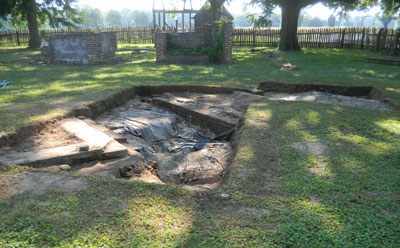
Unbackfilled area in the Calvert House.
In the photo, the two 19th-Century building foundations are visible. To the left, in the foreground, is the dairy while the foundation to the right is the smokehouse. They were built with brick foundations but in the 20th century, concrete was added. Over the next week, we will finish removing the backdirt and straighten the walls. Before we remove the plastic at the bottom, we need to make it look more like an archaeological unit and less like a bomb crater. Once the plastic is removed, it will be necessary to clean and trowel the surface to outline the features present.
Despite spending a large amount of time and effort in the Calvert House area, field school also got a good start on excavating units elsewhere on the site.
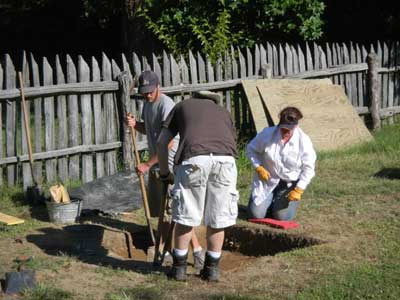
Students excavating unit looking for fences.
The students completed four units and began another two – more than expected in the first week. It kept my assistant Mark and I very busy showing them how to complete all the necessary records. Most of our units consist of a shallow topsoil lying on 8 – 10 in. of a plow zone. The plow zone is the disturbed soil created when the site was used for agriculture in the 18th century. It also includes the 19th-Century surface on which the Brome-Howard House was built. Below plow zone is the subsoil and it is at this level we look for features from the 17th century.
One of the first units completed to subsoil revealed obvious and important features.
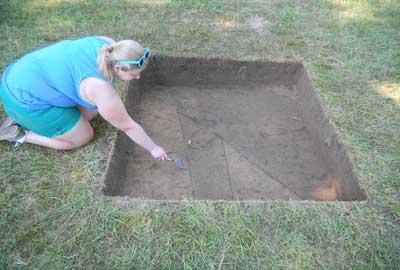
Alice Mutter points to a fence trench below plow zone.
Both of these features have been noted in other parts of the site and the excavation of this square was completed to follow them out. The wide feature, to the right of the unit, is an 18th-Century boundary ditch which, while not fully defined, runs through the Calvert site and continues across the field through the Vansweringen site. The narrow feature is a 17th-Century fence trench which defined the eastern edge of the yard around 1650.
At the Calvert House, we normally begin excavating units on the northern edge of the site, far away from the house foundation. There are fewer features in this area and it usually lets students practice how to excavate before they get into more complex situations. Because the area was less used (hence fewer features), the artifacts are few and far between. For some reason that is not true this summer. From the first day, we began finding ceramics, tobacco pipes, and other artifacts from the 17th through 19th centuries.
Two interesting artifacts from the later period were found at the contact between the topsoil and the plow zone.
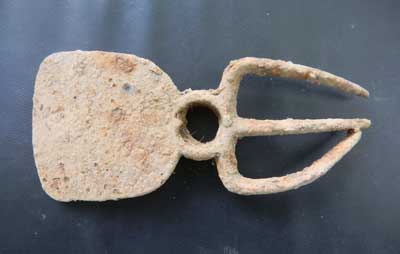
Nineteenth-Century hoe-rake found at the surface of plow zone.
The first is a combined hoe and rake. This combination tool is shown in a mid-19th-Century hardware catalog and a version can probably still be purchased. It was found in a unit by the driveway and one wonders if it was used to help create it. Except for a bent tine, the tool is in good shape and appears to have been lost rather than thrown away. Last summer, in about the same place, we found a complete, useable axe in the driveway. There is no way to prove it but it is interesting to speculate that the driveway was created by the Brome’s slaves and their lack of concern for the tools may represent a form of resistance.
The second 19th-Century artifact is a toothbrush found near the former location of the Brome-Howard House.
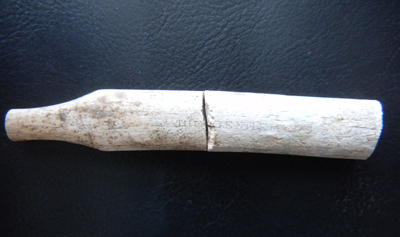
Nineteenth-century toothbrush fragments.
This toothbrush is probably made of celluloid and carries both a brand name and a maker’s mark. The brand name is “THE GENTLE MAN’S” and is visible in the photo. A maker’s mark is less visible but includes a Star of David enclosing an “L” surrounded by “PARIS FRANCE.” Mass produced celluloid toothbrushes were first made in the 1880s. Further research may narrow the time of manufacture or identify the maker.
In addition to these later artifacts, we have also found a large number of 17th-Century artifacts. One of these was a large piece of Rhenish Blue and Gray stoneware from Germany.
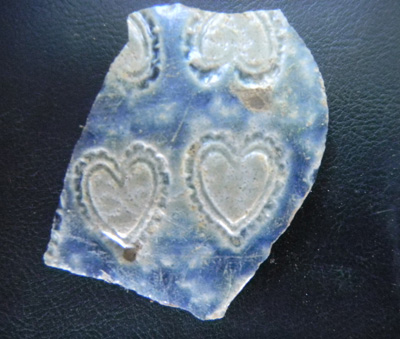
Large piece of Rhenish Blue and Gray stoneware with heart design..
Used for both jugs and table vessels, this type of ceramic is both beautiful and functional. It is a very common type at the Calvert House and the heart-shaped design, seen in the photo, has been found here previously.
Finally, we found a small part of a 17th-century brass buckle.
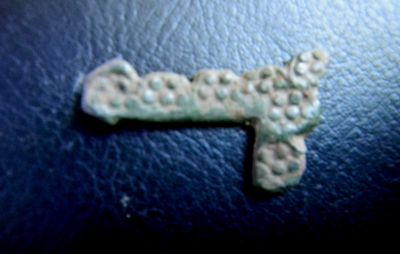
Part of the frame of a 17th-century buckle.
This is part of the buckle frame and it is elaborately decorated. There is the possibility that the brass has a tin wash on it which would have made it look like silver. The piece recovered is too small to know what the buckle could have been used for, but it was clearly for display.


